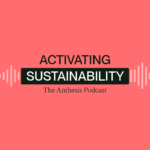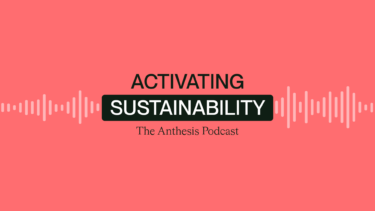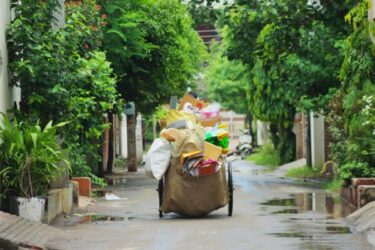
Speakers
Nita P. Woods – Host
Karine Kicak – Associate Director
Natalie Hojell – Senior Consultant
Jackie Fleming – Principal Consultant
Related Topics
Share this episode
In this JUST IN episode of our Activating Sustainability series, our host Nita P. Woods is joined by Associate Director Karine Kicak, Senior Consultant Natalie Hojell, and Principal Consultant Jackie Fleming, to discuss the themes, emerging topics, and key takeaways from GreenBiz’s premier circular economy conference, Circularity24, which took place May 22 – 24 in Chicago, Illinois USA.

Read the transcript
Nita: Hi everyone, and thank you for joining us this week. I am Nita Patel Woods and I am the Client Impact Director here at Anthesis. So today, we’re going to talk about circularity. Now, it’s one of those terms that you might have heard of, but if, like me, you don’t quite understand what it means, you’re not actually alone which is why we are here today with my three lovely guests.
They are all from North America. We have with me today, Jackie Flemming, who is our Circularity Business Models Expert. Karine Kicak, who is our Life Cycle Assessments Expert. And Natalie Hojell, who is our Resource Recovery and Waste Expert. Thank you for joining us today. And today we’re going to talk about how we can together accelerate the circular economy.
So ladies, last month you were gathered in Chicago with over 2, 000 sustainability professionals for the latest Circularity24 conference. Jackie, can you tell me a little bit more about that conference? What is it? Who is it for?
Jackie: Sure. So Circularity 24 is the name of the conference organized by GreenBiz Group. So they’re a U. S. based media and events company. They’re dedicated to sustainability. They organize some of the leading sustainability conferences for the U. S. This conference it’s the leading conference for professionals who are working on building the circular economy. The goal of the conference is to bring together these professionals to discuss key challenges, approaches and tools for implementing circular solutions.
Nita: Okay, so that sounds like a great forum for the three of you, given your job. But Natalie, can you tell me a bit more about why Anthesis were there? What did you actually do?
Natalie: Absolutely. Our objective for attending this conference was threefold. First to network with peers and individuals and generate some business development opportunities. The next was to provide some thought leadership and we had a couple of speaking engagements as well. And then the last was learning to understand some of the emerging trends and topics in the area of circularity. Myself and Karine we’re hosting our own sessions. I hosted a roundtable discussion, which is a moderated open discussion forum where participants are able to chime in on a particular topic. My roundtable discussion was waste as circular feedstock. So this is a really interesting topic. Because it’s relevant for really any material and any industry. We had some great discussions at that round table. There was one person that was making fertilizer out of formerly wasted oat holes. We also had another individual that was making apparel fibers that rivals the hand fail of seeds silk and wool from cellulose waste. It’s really interesting to see that some of the challenges and successes are similar coming from different industries. So it was really interesting opportunity to talk on a topic that I found really interesting.
Karine: And on my end, I had the opportunity of presenting on a panel with 2 of our clients. There was only one session out of the entire conference that focused on LCA. So it was a pretty popular panel, and we were quite happy with the attendance. More specifically, the topic that I presented on focused on the opportunities, but also the limitations of life cycle assessments as a tool to assess whether a circular business model will truly reduce the carbon emissions when we compare it to a linear model so that you can unlock the most carbon emissions reductions.
So we talked about key aspects of a program that’s really important to consider. That can sometimes negate all of the positive impact of the circular solution. So these key aspects included the reverse logistics and whether the circular solution is truly displacing the production of something new because we’ve come to see and talking with our clients that sometimes there can be some rebound effects in certain consumer behavior around circular business models.
Nita: Gosh I’m so pleased that your panels were really well attended. And thank you, Natalie, for bringing circularity into something a bit more understandable. You know, understanding how someone else’s waste actually provides us with a raw material that we would need in everyday clothing or in everyday materials that we see.
I think that sort of brings it down to a level where my mum could understand, which is helpful because sometimes we can get into the technicalities of these things. So on that point, and I’m opening the floor to it to all of you. Can you talk a bit more openly about what circularity actually means like what’s in scope here and you touched on whether or not it’s a good or a bad thing and you touched on whether there’s some actually some negative connotations with circularity. So talk to me about those two things.
Karine: So circularity is really about moving away from that “make, take, waste” economic structure to one that, tries to keep all materials in use for pretty much forever. It’s really a key way to reduce environmental impacts, while demanding less from the environment. So using already extracted and already existing resources much more efficiently, and that can be through an alternative business models or also through a circular intervention, like a design improvement, for example,
Natalie: Just to add on to that circularity can be really challenging because it is not the conventional way that business has always been done. As Karine had mentioned, In a circular economy, there is no waste. The idea of waste doesn’t exist. Certain externalities of doing business like waste and pollution are only now becoming more important considerations in business and are really key concepts in the idea of circularity.
Jackie: Nita, you asked about what is in scope when we talk about circularity. So it is a broad term. Let’s look at what we consider to be a part of this circularity concept . There’s a range of considerations when thinking about circularity, at least in a business context, the considerations would include product design as a foundational step here.
So that includes the choices around material selection and design for things like durability, repairability and recyclability for both the product and the packaging. And then it also means looking specifically at end of life solutions that will keep the products or material components recirculating at their highest value as Karine mentioned, and minimizing any waste-to-landfill, like Natalie mentioned, and that’s the work that Natalie specializes in. And then it also includes the work that I specialize in, which is looking at the business model as a whole and looking at how companies can apply monetize their existing products over multiple uses, how they can disconnect revenue generation from impact creation, utilizing a much lower carbon way of doing business. And then we also consider LCA as an important tool in the circularity journey. Because Nita, you asked about potential negative
trade offs with circularity. So in order for these circular efforts or actions to be truly creating a sustainability benefit, we need to make sure that we can measure the actions and the interventions that we’re taking, evaluate those impacts and be able to confirm that there’s overall net benefits. So LCA is an important tool to be able to do that within the circularity journey. And then all of these topics and approaches can be coordinated by incorporating circularity as a key part of an organization’s sustainability strategy. So all of those pieces together would encompass what we consider as the best practice approach for businesses that are looking to, have a comprehensive or robust circularity strategy.
Nita: Thank you all for explaining that. And for those that don’t know, LCA stands for Life Cycle Assessments. So if I’ve understood you correctly, circularity and circular business models are the strategy. But the way that you measure the success of those strategies are tools like the Life Cycle Assessment.
So tell me a little bit more about what happened at the conference. If I was to challenge you to say, what are your top two takeouts? What would you tell me that you got from being there for a couple of days?
Jackie, why don’t you kick us off?
Jackie: Sure. So it was encouraging to see that there were multiple sessions at the conference that were focusing on circular business models. Again, that’s the area that I work in, it’s really encouraging. To see that because we need more action at that level. So I’m not just designing products to try to have those products be more repairable or using more durable materials, but looking at how we are restructuring our economic models. However, what was interesting to see across these sessions is that there is still a lag in putting the focus on this question of how truly sustainable is that circular model. So designing the circular model is really important. Having the ambition for businesses to do that is a really important first step. But then question of how sustainable the model is needs to be that consideration that’s made alongside the design of the program. So in one panel, there was a particular focus on explaining the financial benefits of circular business models, which is really important for getting that executive level buy in.
within a business to support the design and the launch of a circular model being able to make the financial business case. But this panel the speakers acknowledged that they had not yet reached the step of designing and measuring their model for a more explicit understanding of the model with a couple of considerations that we’ll get into in terms of what that means.
Nita: Can I ask a question about that? So when you talk about the sustainability of the business model, are you referring to, can it exist? Are we designing it so that the feedstock continues to be available, or do you mean the sustainability of it in terms of the environmental and social impacts?
Or do you mean both?
Jackie: It’s a great question. And no the implication here is understanding impacts of the model. And so just to share an overview, there’s a few important considerations when we’re looking at that question of, ‘ is this model just shifting impacts or is it actually reducing overall impacts?’
And is it shifting the way that consumerism happens . And so first consideration is this question that Karine mentioned in the beginning around her panel, which is a question of displacement. Is the consumer actually displacing their purchase of something new with the purchase of something used?
Or is the circular model incentivizing just an add on purchase of something used? Is it an opportunistic purchase? Because you’re offering goods or items that may be lower cost that the consumer may feel are more guilt free as a way of shopping. So is it actually increasing overall consumerism? So that would be one question. And again, Karine will speak more to how LCA can take that into consideration. So then another consideration there is the CBM, the circular business model actually structured to encourage more consumerism through the incentives. So for a circular model, businesses need to be able to take back their own goods so they can recirculate those goods.
And so often there’s incentives needed for consumers to submit their products back to the brand. We do see many examples where brands are incentivizing that take back through things like gift cards for the consumer. And those gift cards in many instances may only be applicable to the purchases of new products. Therefore, the brand may be incentivizing consumers to buy more new stuff when when the y send back their old stuff. So then the final consideration here is whether the business is actually. Striving to have their circular model start to make up more of their revenue goals going forward in place of new production versus are they looking to add the circular model as an additional revenue stream?
Nita: This is where I’d really love to bring in Karine and Natalie, because I understand both of you have got a lot of clients that work in the fashion, clothing, apparel sector. So tell me a little bit more about that tutorial that you went to specifically on textiles that brings to life what Jackie is talking about.
Karine: so Natalie and I attended a 3 hour tutorial session focused on textile recycling since we both support many clients in the apparel sector and we thought it’d be great to go in and get some insights that we can then share back with our clients.
In these panels that they presented, they had textile waste aggregators. They had sorting companies, and they also had recycling companies. There was lots of discussions around the challenges that we’re all facing in the apparel sector with the lack of technology and the infrastructures to support efficient textile-to-textile recycling solutions at scale The discussions were quite lively and really interesting. However, when I left that session and other sessions as well throughout the conference, I was thinking to myself we’re talking a lot about the barriers to circular economy at scale and we’re talking about what the ultimate solution could look like, but we’re not offering many concrete solutions for now.
Karine: What are we going to do in the meantime so it was really important for me in the panel that I was about to present that I think of suggesting something more concrete to the audience. A more clear examples of success and solutions when it comes to using LCA as a tool to measure the potential of a circular business model and making sure that we’re setting it up for success so that it’s really leading to the most carbon reductions or any environmental impact reductions. I think I was able to achieve that. We did receive some positive feedback on the panel afterwards from attendees. They shared that it thought it was really refreshing to hear about solutions about how LCA can help, better understand the potentials in circular business models.
Natalie: And I wanted to add to that point as well, because one of my key takeaways from the conference, we talked a lot about the elephant in the room, what is the thing that people are thinking of, but not saying, and from my perspective, what kept coming up was money. So from that panel that we attended, one of the people represented was from a textile recycling company that recently went bankrupt. Part of the big reason for this is that the longterm commitments from brands to offtake this material was just lacking. So corporate leadership really needs to feel secure in making investments that really change their business model from linear to circular. So that does require in some cases, significant investments.
It’s a big disruption to the way business has typically been done and there’s definitely risk involved in that. So tools like LCA are really good way to do this to help demonstrate to corporate leadership that there is a real benefit in making those investments. Another thing that I noticed was that a lot of companies are trying to tackle circularity for their own products and packaging.
I think this is why circularity is so difficult for people to understand is because it can mean so many different things for different companies However, the problem of circularity or the topic of circularity is really systemic. This linear business model moving to a circular business model requires a whole reverse supply chain that currently just doesn’t exist.
So I think there are a lot of opportunities for companies rather than everyone trying to do their own individual siloed take-back program to work more collaboratively, work together better to utilize existing infrastructure that makes circularity easier and more efficient than each company doing its own thing.
Nita: Natalie, I think you make such an interesting point because I think you’re right. I think businesses do understand their own supply chains and they try and be circular, but it sounds to me like if people were working together across industry, across sector, to find more innovative ways to partner, in ways that they wouldn’t naturally, that seems to be the way we might go forward.
So Jackie, are there any examples of like, how businesses might start to think in that kind of cross collaborative way?
Jackie: In response to that, there was one example of a session that was focusing on collaboration to address a need for a stronger network of localized recycling capabilities. This also gets at what Natalie was talking about, in terms of the need for more infrastructure around reverse supply chains. So this is a really relevant need from sectors as different from each other as electronics and to textiles. Right now items are shipped around the world to get recycled. And so building out the infrastructure on a local level is really key. And we did see, one example of how that’s happening.
There is a new partnership that was just launched called the Circular Supply Chain Coalition. It includes partners like Pysera Global and then FedEx as a logistics partner. And then the goal is to boost the U. S. supply chain of critical minerals for new tech hardware by mining discarded
Jackie: consumer electronics, which is also called urban mining. So it was really interesting to see how this coalition is trying to bring together logistics companies and then local community enterprises to tap into this more distributed supply of critical minerals and shift the model for how those minerals are sourced while building out local community partnerships that could have a social benefit as well,
like, employment opportunities for special needs populations. So the session discussed the aspirations and the goals for this initiative, and then also just highlighted where we don’t yet have the right systems in place for that effective urban mining. There’s a need for more digital infrastructure for data collection on those materials, forecasting material needs, routing materials for their highest use. And so that is a theme that we saw across sessions too, that there, even where there are examples of some collaboration trying to develop solutions, there’s still a long way to go.
Natalie: I love that term of urban mining. That’s a great example of, using waste as a circular feedstock. And this really relates back to one of the key themes that I was seeing was that it is a good solution to use existing infrastructure rather than developing a brand new supply chain from scratch.
That can be really challenging and really resource intensive. So one of the sessions that I attended also had a really interesting innovative company that was converting existing trucks from conventional to electric. So just another great example of using what you already have but making that more efficient. Another company discussed about how they are using empty mall space for micro reverse logistics hubs. So this is another just great example of using that infrastructure that we already have to go towards a more circular economy.
Nita: Thanks, Natalie. And I think you really touched on something that where it becomes so much more tangible if you can start to see the impact of that, as a resident of somewhere that has lots of empty shopfronts, being able to see how a community might use that really brings it to life. So it sounds like we’ve got some, strategic models that we know exist out there.
We’ve got some partners and organizations working together to actually start to demonstrate it. I wonder if Jackie, maybe you could kick us off here. What are the tools out there that help us measure the effectiveness of actually implementing circular solutions?
Jackie: Sure. Karine will speak more to life cycle assessment like we mentioned as a really foundational tool. But there was also a session that was providing more of an overview and an update on a different framework and methodology called the Circular Transition Indicators or CTI. And so the background on CTI as a framework it began in 2018 with companies coming together within WBCSD to figure out how to create a new metric to measure circularity with the goal that the metric could then be shared in disclosures that particularly in the EU market that there would be a need having a more standardized framework for sharing overall circularity progress. So the CTI framework is aligned to the CSRD reporting standards in Europe. And it is meant to be able to offer scenario modeling to support decision making for carbon emissions for nature impacts and social impacts. So it is meant to be broader than what the LCA tool is currently able to do. But what was really noticeable is that most attendees in the room for this session that was providing the overview and the update on where the CTI methodology is currently, when we had discussion within the session, we saw that most attendees are not using the CTI methodology. It’s fairly complex and technical. And here in the U. S. and then other regions where it’s not yet a requirement to use standardized frameworks. It’s not yet a requirement to report on circularity. Businesses will be less likely to use it if it’s complex and technical. And sometimes we saw is that there has not yet been great adoption of this methodology.
Nita: And do you think, Jackie, that the regulation as we’ve seen it in the European regions will force adoption, or do you think it will make the regulators innovate to create metrics that are a bit more accessible to everybody?
Jackie: I expect to see that there will be more adoption of a framework like CTI in Europe, where the framework already is available and reporting requirements are going to increase. And so businesses would likely turn to a framework that is already available in Europe. It would be great to see continued innovation of metrics that can feel more intuitive or accessible as well. We wouldd probably expect to see that CTI will continue to iterate as there has been an evolution of new versions of CTI. And so hopefully it will feel like between more widespread education and training on how to use it and maybe better ways of simplifying and making it feel accessible that will see more widespread adoption. But Karine can speak more to LCA and that tool along with CTI. It may be that businesses will continue to seek out support from expert providers that can help them to conduct these kinds of measurements.
Karine: I would add LCA is a globally recognized framework. There is an ISO standard that explains how to perform an LCA and how to use the results of an LCA. So it’s pretty well understood, but it’s still just one tool out of many tools in the toolbox that can be used for companies to set goals and track progress when it comes to circularity. So like Jackie mentioned, there’s different frameworks and methodologies and many KPIs that are commonly used. Namely there’s the material circularity indicator MCI, which was developed by the Ellen MacArthur Foundation and the circular transition indicators, the CTI that Jackie just explained.. These frameworks use units or indicators that can be quite technical to use, and they’re not always very tangible metrics, and they’re sometimes hard to read and to interpret sometimes they’re dimensionless, so they don’t have units, so it’s hard to remember if it’s a good value or if it’s a bad value between zero and one, but they certainly do have merit, and many companies effectively use them, and we see that CSRD is now pushing towards the CTI.It goes to see that companies will be
using if they aren’t already using those frameworks. My point of view is that looking at results in terms of reduced carbon emissions or using less gallons of water can sometimes speak better than certain of those metrics. So my recommendation is that these two frameworks and Lifecycle Assessment should just be used complementarily.
Nita: We could probably talk about this for hours. It sounds complex. It sounds interesting, but it sounds like there’s some real innovation being made. Okay, but as we wrap up, is there one last thing that you want to share from your time at the Circularity24 conference?
Jackie:I can share another example on the topic of tools and how we still have a long way to go. There was a session on digital product passports that was interesting because there was a leading top global tech brand speaking about their experience in trying to develop a digital product passport program.
The panel discussion really focused on all of the challenges being faced. And then the takeaway being that it is still not yet a viable tool that is in use by this tech company. That they’re still trying to get there and it sounded from some discussion around the room that, it’s clear that no one has this figured out yet.
Digital product passports are an exciting prospect. But we still have a great lack of the needed digital infrastructure across the supply chain. Even though challenges still do feel more prevalent than solutions, it’s the overall reflection from the conference is it’s still more important than ever to have businesses taking action, trying to solve these problems together and recognizing the urgency in doing so.
Natalie: I just wanted to jump in really quickly and just mention another theme of what’s the motivator? Is it a carrot or a stick? Carrots being, the incentives to transition to a more circular business model. So traditionally we think of these things as, grants or awards, but I’m also seeing carrots as, voluntary actions from peers or competitors that are making steps in this space. Not mandatory, but drivers to differentiate your brand or move in the direction of the industry. And sticks, of course, being mandatory regulation that we are seeing more and more of. From CSRD to mandatory EPR, which is extended producer responsibility, which is big regulatory driver for waste and resource recovery and packaging. So just a little bit of a note on those drivers.
Nita: Thanks, Natalie. So how can Anthesis help clients with this? What are our solutions?
Karine: We have circularity task force at Anthesis, which all three of us are a member of, plus two of our colleagues. So this task force really exist to help companies set their circularity strategy we’re here to try to help them understand where they are at in their circularity journey, whether it’s, starting with setting a baseline or simply understanding, their sector circularity landscape. And then, we can help them set circularity goals and set them up with the right tool so that they can then calculate the progress against these goals that we’ve helped them set.
Jackie: And that circularity task force coordinates between all of our respective services that we offer within specific aspects of circularity. For each of us to maybe speak to our specialty service within that task force, I can speak to how we can support companies who are looking to either develop a circular business model or optimize a circular business model.
Our offering there is pretty unique in the market as we design a business within a business for our clients. If we are starting from the beginning and developing proposed models, we build out the whole operational back end of the model along with pro forma PNL’s that need to be able to demonstrate that the model can be profitable, ideally by year one.
So we’re able to support our clients from that initial concept through to implementation, helping them launch the model. And then helping to optimize those models
Natalie: So my team, the resource recovery and waste team, we support clients on understanding their waste baseline and their waste performance and improving their performance after baseline has been either established or understood. Then we really work on connecting and understanding of the upstream processes that generate waste. Where is waste coming from and why, and then connect those processes with downstream solutions.
Karine: Once Jackie and Natalie service lines have helped define what a circular solution could look like, that’s when LCA will jump in and help with the implementation and the optimization piece of the program. As I mentioned before, LCA will really help pinpoint what will be the most sensitive parameters to work on to ensure that circular solution is indeed reducing environmental burden. And then, again, I can’t stress this enough, the main advantage of an LCA is that we can run these scenario modeling and try to see how that displacement assumption and that rebound assumption will play a role in whether that circular business model will be yielding some benefits or not.
Jackie: And across these services, our colleagues bring a diverse range of expertise coming from industry backgrounds and brand side experience. So we strive to be collaborative and connecting the best experts to every project and collaborating amongst each other to bring the most value to our clients and what they’re looking to achieve.
Karine: Yeah, and I think our job is really to just, stay current with the latest trends and innovation when it comes to circularity.
Natalie: And that, again, just ties back to one of our main objectives for attending this conference is staying on top of that innovation and technology and trends. Thank
Nita: you, I really enjoyed this conversation. And as Karine mentioned, it can be hard going if all you’re hearing is the barriers, the problems, the this is why we can’t do it. But I feel like, the three of you have just articulated such a neat way in which any organization, no matter where they are in this journey, can come and meet with some of our really solutions-orientated experts.
So if listeners want to know more, where can I direct them, Jackie? Who should they get in touch with?
Sure. So in the episode notes, we’ll include a link to the web page on our site that shares the collection of all of our circularity services. So descriptions of those services and how we approach the work along with case studies and other resources. And so that would be the best place to learn more about the services and our contact information will be shared within the episode notes.
Jackie: So we encourage any listener to reach out to us directly if they want to discuss further questions or needs
Nita: Perfect. Thanks, Jackie. And whilst you are on our website, I’d really encourage you to check out the other podcast episodes covering circularity, circular business models, and everything else in that vein. So we’ve got over 10 episodes that features similar content to the ones we’ve had on today talking about our experiences with live clients, such as Microsoft,
so using real life examples. As well as an episode talking to Natalie’s point around how to unlock investment in the circular economy. Or if you are interested, listen in to the Wise Women in Waste podcast episode about how to navigate your career, particularly as a woman in this type of work. Thank you again for listening to the Anthesis podcast.
Please do check out the latest news and blogs on our website, anthesisgroup.com, and we will be back next month for more news and sustainability insights.
Inside this episode
- What key topics and discussions were happening at Circularity24?
- What is ‘circularity’, and what does it mean for businesses?
- What challenges are businesses facing and what are the possible solutions for implementing circular business models?
- Will circular economy be part of the emerging sustainability regulation landscape?
- What were the main actions or takeaways from the event?
If you have any feedback on the podcast, get in touch with our host Chris Peterson at: Chris.Peterson@anthesisgroup.com















